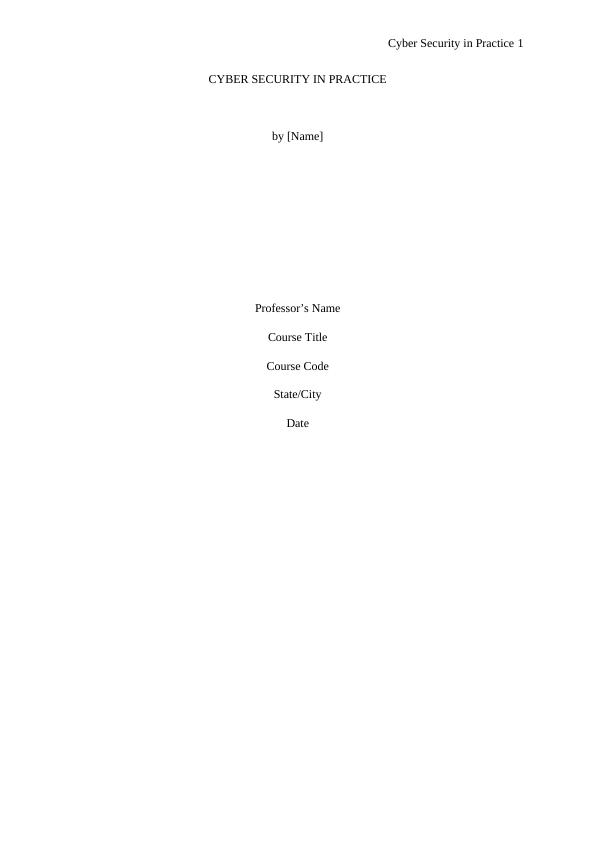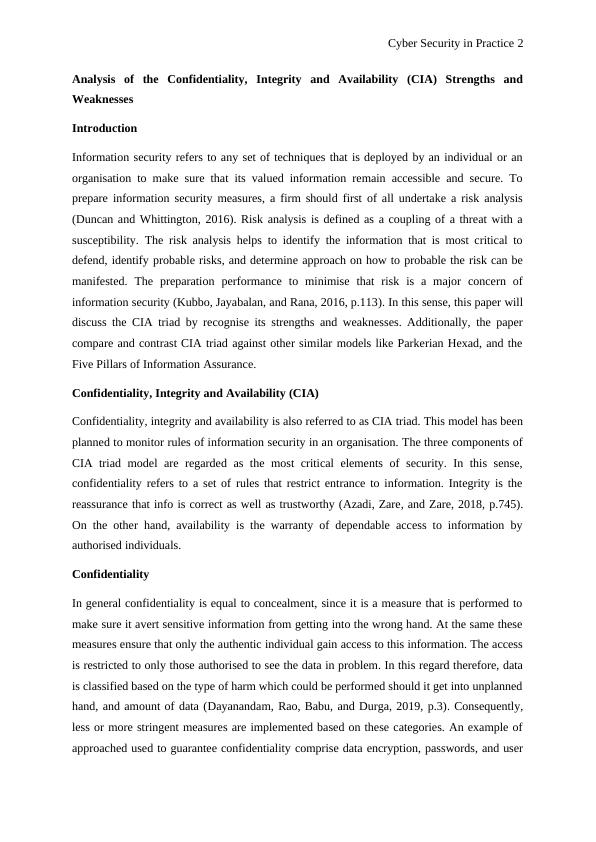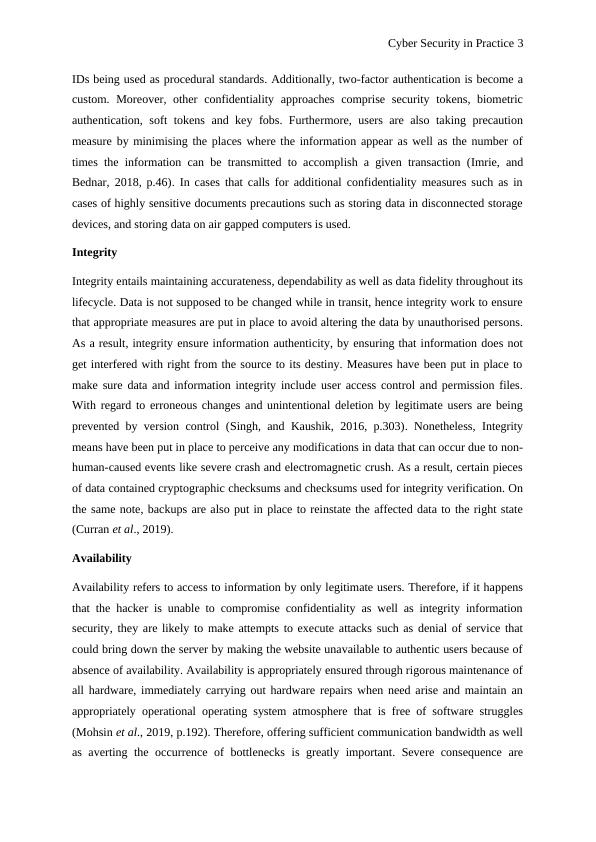Cyber Security in Practice
Added on 2022-12-29
10 Pages3837 Words96 Views
Cyber Security in Practice 1
CYBER SECURITY IN PRACTICE
by [Name]
Professor’s Name
Course Title
Course Code
State/City
Date
CYBER SECURITY IN PRACTICE
by [Name]
Professor’s Name
Course Title
Course Code
State/City
Date

Cyber Security in Practice 2
Analysis of the Confidentiality, Integrity and Availability (CIA) Strengths and
Weaknesses
Introduction
Information security refers to any set of techniques that is deployed by an individual or an
organisation to make sure that its valued information remain accessible and secure. To
prepare information security measures, a firm should first of all undertake a risk analysis
(Duncan and Whittington, 2016). Risk analysis is defined as a coupling of a threat with a
susceptibility. The risk analysis helps to identify the information that is most critical to
defend, identify probable risks, and determine approach on how to probable the risk can be
manifested. The preparation performance to minimise that risk is a major concern of
information security (Kubbo, Jayabalan, and Rana, 2016, p.113). In this sense, this paper will
discuss the CIA triad by recognise its strengths and weaknesses. Additionally, the paper
compare and contrast CIA triad against other similar models like Parkerian Hexad, and the
Five Pillars of Information Assurance.
Confidentiality, Integrity and Availability (CIA)
Confidentiality, integrity and availability is also referred to as CIA triad. This model has been
planned to monitor rules of information security in an organisation. The three components of
CIA triad model are regarded as the most critical elements of security. In this sense,
confidentiality refers to a set of rules that restrict entrance to information. Integrity is the
reassurance that info is correct as well as trustworthy (Azadi, Zare, and Zare, 2018, p.745).
On the other hand, availability is the warranty of dependable access to information by
authorised individuals.
Confidentiality
In general confidentiality is equal to concealment, since it is a measure that is performed to
make sure it avert sensitive information from getting into the wrong hand. At the same these
measures ensure that only the authentic individual gain access to this information. The access
is restricted to only those authorised to see the data in problem. In this regard therefore, data
is classified based on the type of harm which could be performed should it get into unplanned
hand, and amount of data (Dayanandam, Rao, Babu, and Durga, 2019, p.3). Consequently,
less or more stringent measures are implemented based on these categories. An example of
approached used to guarantee confidentiality comprise data encryption, passwords, and user
Analysis of the Confidentiality, Integrity and Availability (CIA) Strengths and
Weaknesses
Introduction
Information security refers to any set of techniques that is deployed by an individual or an
organisation to make sure that its valued information remain accessible and secure. To
prepare information security measures, a firm should first of all undertake a risk analysis
(Duncan and Whittington, 2016). Risk analysis is defined as a coupling of a threat with a
susceptibility. The risk analysis helps to identify the information that is most critical to
defend, identify probable risks, and determine approach on how to probable the risk can be
manifested. The preparation performance to minimise that risk is a major concern of
information security (Kubbo, Jayabalan, and Rana, 2016, p.113). In this sense, this paper will
discuss the CIA triad by recognise its strengths and weaknesses. Additionally, the paper
compare and contrast CIA triad against other similar models like Parkerian Hexad, and the
Five Pillars of Information Assurance.
Confidentiality, Integrity and Availability (CIA)
Confidentiality, integrity and availability is also referred to as CIA triad. This model has been
planned to monitor rules of information security in an organisation. The three components of
CIA triad model are regarded as the most critical elements of security. In this sense,
confidentiality refers to a set of rules that restrict entrance to information. Integrity is the
reassurance that info is correct as well as trustworthy (Azadi, Zare, and Zare, 2018, p.745).
On the other hand, availability is the warranty of dependable access to information by
authorised individuals.
Confidentiality
In general confidentiality is equal to concealment, since it is a measure that is performed to
make sure it avert sensitive information from getting into the wrong hand. At the same these
measures ensure that only the authentic individual gain access to this information. The access
is restricted to only those authorised to see the data in problem. In this regard therefore, data
is classified based on the type of harm which could be performed should it get into unplanned
hand, and amount of data (Dayanandam, Rao, Babu, and Durga, 2019, p.3). Consequently,
less or more stringent measures are implemented based on these categories. An example of
approached used to guarantee confidentiality comprise data encryption, passwords, and user

Cyber Security in Practice 3
IDs being used as procedural standards. Additionally, two-factor authentication is become a
custom. Moreover, other confidentiality approaches comprise security tokens, biometric
authentication, soft tokens and key fobs. Furthermore, users are also taking precaution
measure by minimising the places where the information appear as well as the number of
times the information can be transmitted to accomplish a given transaction (Imrie, and
Bednar, 2018, p.46). In cases that calls for additional confidentiality measures such as in
cases of highly sensitive documents precautions such as storing data in disconnected storage
devices, and storing data on air gapped computers is used.
Integrity
Integrity entails maintaining accurateness, dependability as well as data fidelity throughout its
lifecycle. Data is not supposed to be changed while in transit, hence integrity work to ensure
that appropriate measures are put in place to avoid altering the data by unauthorised persons.
As a result, integrity ensure information authenticity, by ensuring that information does not
get interfered with right from the source to its destiny. Measures have been put in place to
make sure data and information integrity include user access control and permission files.
With regard to erroneous changes and unintentional deletion by legitimate users are being
prevented by version control (Singh, and Kaushik, 2016, p.303). Nonetheless, Integrity
means have been put in place to perceive any modifications in data that can occur due to non-
human-caused events like severe crash and electromagnetic crush. As a result, certain pieces
of data contained cryptographic checksums and checksums used for integrity verification. On
the same note, backups are also put in place to reinstate the affected data to the right state
(Curran et al., 2019).
Availability
Availability refers to access to information by only legitimate users. Therefore, if it happens
that the hacker is unable to compromise confidentiality as well as integrity information
security, they are likely to make attempts to execute attacks such as denial of service that
could bring down the server by making the website unavailable to authentic users because of
absence of availability. Availability is appropriately ensured through rigorous maintenance of
all hardware, immediately carrying out hardware repairs when need arise and maintain an
appropriately operational operating system atmosphere that is free of software struggles
(Mohsin et al., 2019, p.192). Therefore, offering sufficient communication bandwidth as well
as averting the occurrence of bottlenecks is greatly important. Severe consequence are
IDs being used as procedural standards. Additionally, two-factor authentication is become a
custom. Moreover, other confidentiality approaches comprise security tokens, biometric
authentication, soft tokens and key fobs. Furthermore, users are also taking precaution
measure by minimising the places where the information appear as well as the number of
times the information can be transmitted to accomplish a given transaction (Imrie, and
Bednar, 2018, p.46). In cases that calls for additional confidentiality measures such as in
cases of highly sensitive documents precautions such as storing data in disconnected storage
devices, and storing data on air gapped computers is used.
Integrity
Integrity entails maintaining accurateness, dependability as well as data fidelity throughout its
lifecycle. Data is not supposed to be changed while in transit, hence integrity work to ensure
that appropriate measures are put in place to avoid altering the data by unauthorised persons.
As a result, integrity ensure information authenticity, by ensuring that information does not
get interfered with right from the source to its destiny. Measures have been put in place to
make sure data and information integrity include user access control and permission files.
With regard to erroneous changes and unintentional deletion by legitimate users are being
prevented by version control (Singh, and Kaushik, 2016, p.303). Nonetheless, Integrity
means have been put in place to perceive any modifications in data that can occur due to non-
human-caused events like severe crash and electromagnetic crush. As a result, certain pieces
of data contained cryptographic checksums and checksums used for integrity verification. On
the same note, backups are also put in place to reinstate the affected data to the right state
(Curran et al., 2019).
Availability
Availability refers to access to information by only legitimate users. Therefore, if it happens
that the hacker is unable to compromise confidentiality as well as integrity information
security, they are likely to make attempts to execute attacks such as denial of service that
could bring down the server by making the website unavailable to authentic users because of
absence of availability. Availability is appropriately ensured through rigorous maintenance of
all hardware, immediately carrying out hardware repairs when need arise and maintain an
appropriately operational operating system atmosphere that is free of software struggles
(Mohsin et al., 2019, p.192). Therefore, offering sufficient communication bandwidth as well
as averting the occurrence of bottlenecks is greatly important. Severe consequence are

End of preview
Want to access all the pages? Upload your documents or become a member.
Related Documents
Information Security: CIA Triad, ATM Security, Biometric Authentication, Caesar Cipherlg...
|13
|2577
|292
Cyber Security CIA: Confidentiality, Integrity, and Availabilitylg...
|10
|2334
|49
Implementation of CIAlg...
|4
|768
|382
Information Securitylg...
|17
|4456
|84
Fundamental Concepts of Information System Securitylg...
|9
|2417
|66
Information Security: CIA Triad and Biometric Authenticationlg...
|16
|4179
|385
